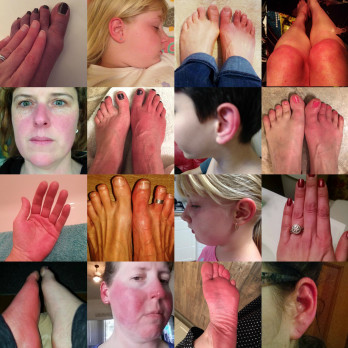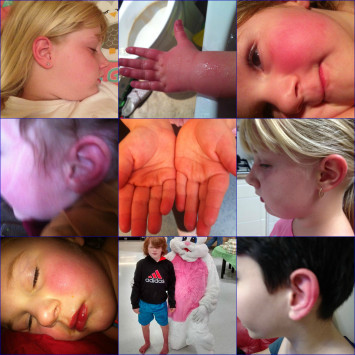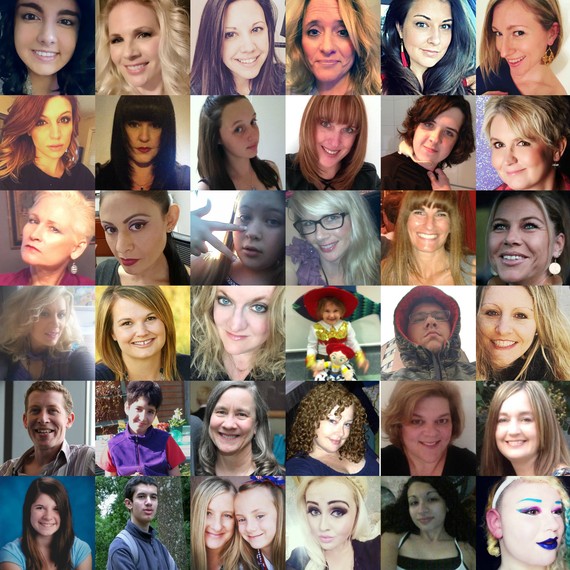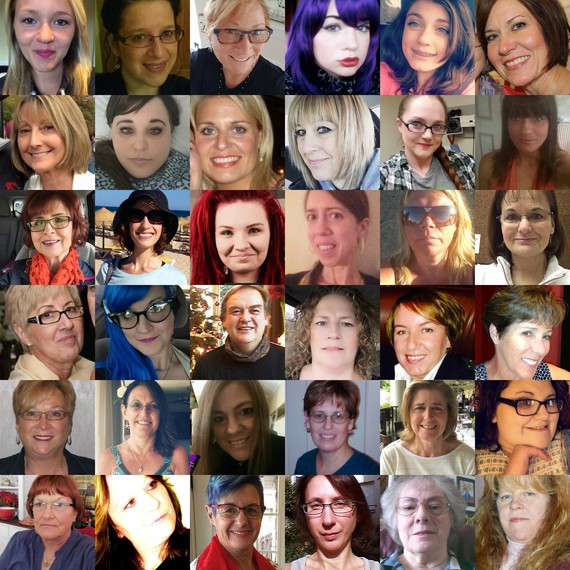Please help us put the fire out
Imagine yourself living during the medieval times, and although you're an innocent person, you're about to be secured to a wooden post and burned alive while a crowd of people watch.
That pretty much describes the impending doom when diagnosed with Erythromelalgia (EM). The only differences are EM sufferers' burn alive on a daily basis -- and we're not tied to a stake.
With today's technology, it's hard to believe we're still somewhat living in the stone ages in understanding EM. The exact underlying cause remains unknown. However, the condition is thought to result from vasomotor abnormalities or dysfunction in the normal narrowing (constriction) and widening (dilation) of the diameter (caliber) of certain blood vessels, leading to abnormalities of blood flow to the extremities.
EM causes severe burning pain, noticeable redness (erythema) of the skin, swelling, and increased skin temperature, particularly of the feet. However, the hands, face, ears, and limbs can also be affected. Although both sides of the body are usually affected, it can be limited to only one side. Primary EM may occur randomly for unknown reasons or rarely may be familial. Secondary EM occurs when an underlying condition such as an autoimmune disease, neuropathy or Lyme disease is present, to name a few. Some people burn continuously throughout the day while others have intermittent episodes of "flaring." The excruciating flares can last from hours to days at a time. Nighttime tends to be worse. Episodes are mostly brought on by warm temperatures, eating spicy food, alcohol consumption, temperature fluctuations, exercising and walking. The pain can be so intense that a patient cannot walk.
The first stage of misery is figuring out your own diagnosis. Most EM patients journey from one doctor to the next for several years before receiving an accurate diagnosis. It's not uncommon to be misdiagnosed with Raynaud's disease, cellulitis or various other conditions. In my case, I obsessively researched my symptoms online for nearly a year before coming across a few EM pictures. I was absolutely terrified. I didn't think it was possible I could be "1 in 100,000." I knew I was a unique person but seriously? C'mon. That had been the one time I'd rather be just like everybody else in the world.
Because the disease is rare, most doctors have never seen or heard of it. I brought in an EM brochure and cell phone pictures to show my local neurologist. He had only seen one previous case in his 30-year career. Apparently I lucked out in that he had at least seen it before. I decided to make the two-hour excursion to Johns Hopkins for further testing. After repeated visits with various specialists, blood work, urine samples, and gene mutation testing, I am still in the same position today -- no answers.
The endless voyage has just begun once a patient receives their official diagnosis. Several doctors turn patients away because they don't feel comfortable treating a disease they've never heard of. Some physicians aren't willing to work with patients when it comes to experimenting with various medications until some form of relief is found. Unfortunately there's no understanding on which type of doctor a patient should see -- neurologist, dermatologist, hematologist, rheumatologist, podiatrist, geneticist, internal medicine, cardiologist, pain management or a primary care physician.
The pain feels and looks like a scorching fire inside the limbs. Desperation leads a patient to erratic thoughts of flying across the county to see any renowned doctor who could possibly provide some relief. I'd jump up and down on one leg in a blazing desert while eating live crickets if a doctor said it would cure me. It reminds of that 1980s USA commercial with their infamous motto, "What would you do for a Klondike bar?" For us, the saying would be, "What would you do for an EM cure?" I'm sure our applicants could get pretty creative. I don't want to accept a portable fan and foot elevation as my only means of continued existence the rest of my life.
The pain is often unbearable, and the suicide rate is high. When I first got diagnosed I made the mistake of going online and researching "Erythromelalgia stories." I read obituaries of victims who could no longer deal with their excruciating pain. I also came across EM clinical trials where some patients had died by suicide before the trial concluded. I read the phrase "wheelchair bound" in several articles. I felt incredibly isolated, afraid, and far away from the ordinary world.
No one medication, therapeutic method, or procedure has been consistently effective for EM. It's well noted that ice water immersions, although cooling, have a negative impact on the disease itself and can cause further complications such as ulcers. Like lab rats, we're forced into experimenting with various medications, vitamins and herbal remedies due to our poor quality of life.
The side effects are a whole different story. Chances are high a patient has wasted money on a wide range of creams that provided little to no relief. A small percentage of people have benefited from formulated compound creams, but none of them have worked for me. To me that's camouflaging the "real" underlying problem, whatever that may be. Pain patches are another source of mild pain relief but it does little for quality of life. The Erythromelalgia Association (TEA) founding member, Dr. Jay S. Cohen, M.D., personally suffered with the disease and offered several medical and natural treatment options to explore. Thanks to him, I take several supplements that assist in my daily survival. Dr. Cohen passed away on December 6, 2015. His obituary did not state his cause of death. His passing was a major loss to the medical community and particularly sad for EM sufferers.
EM does not discriminate by age, nationality, or gender. It's a tough disease for adults to tolerate let alone children. Some EM children have never known a life without pain. We take for granted how simple life should be for youngsters -- sleep, eat, learn, play, love. Imagine if every day were an agonizing struggle for your child? Many adolescents endure painful flares during school hours, requiring their parents to pick them up. Most of them are not able to participate in physical education class with their friends. The intermittent flaring makes it challenging to maintain good attendance. It often times forces parents to make the difficult decision of having their child home schooled. For all these reasons, engaging socially can have its own set of problems for many youths.
A few of our courageous little warriors
I have EM in both hands and feet and sometimes my ears. I suffer with chronic pain on a daily basis. As a result I've become a fraction of the person I used to be. I once had been an extroverted, funny person who brightened a room with my contagious laughter. Too much excitement now can cause a few hours of pain, so I try not to overexcite my nerve cells. My days are spent enduring sporadic flares, not knowing if one episode will feel worse than the previous. Sunlight used to be my biggest enemy, but now I flare anytime, anyplace for no specific reason. Cooking, cleaning and holding my cell phone causes my hands to flare often. Walking for longer than 30 minutes can cause my feet to flare depending on the weather. The swollen, fiery throbbing is indescribable. I breathe through the pain then pray it passes soonest. No specific drug has relieved my symptoms to date.
It would be a great morale booster to go one full day without pain. But then I take a shower and typically the fire begins. Possibly the fire waits until I turn on my blow dryer or curling iron. Maybe I luck out and the fire holds off until a temperature change is triggered. Eventually, the heat is on regardless of what I do. The fire walks with me wherever I go.
I'm reminded daily of my constraints when I walk in my closet to get dressed. I have lots of clothes and shoes I haven't worn since my EM diagnosis. A bulky sweater and flip flops doesn't exactly go well together. Besides, heavy clothing can cause overheating and that's a nightmare. One side of me says, "Get rid of those clothes and shoes. You'll never be able to wear them again." Then the hopeful side of me says, "By giving away those items you're surrendering ALL hope for relief or a cure."
It's difficult for family and friends to understand this disease. Although they love us unconditionally and understand we're suffering, who could comprehend the feeling of burning alive every day? It's hard for others to grasp this type of pain, depression, and lonesomeness. Many of us mask our sorrows. I sometimes cry in the shower or when I'm driving in my car. I feel like I'm watching my life wither away. EM doesn't just affect the patient, it impacts their entire family. Our condition limits any events our loved ones would ever want to plan with us. Reality strikes knowing there won't be any more hot sunny outdoor activities to enjoy. A summer gathering now sends signals of great sadness because we can't comfortably be a part of it. Will there ever be a time we can sit in the sunshine feeling the rays of warmth on our skin without pain? Will a day arrive when we can go for long walks, hiking or bicycling again? Those memories are quickly fading and being replaced with tears of loneliness.
It's unfair for families to hold back living their lives so we pretend to maintain a smile while observing from afar. We'd love to physically do all the things they can but that's impossible right now. Many of us are on disability while others struggle to get approved for it. I am still able to work. I get up daily and head to the office, finish my shift, go home, sit on the couch, eat, sleep, then repeat the next day. I have a fan on my desk (of course). I'm surrounded by the same walls day in, day out. The routine makes me feel like I'm not living anymore. I'm merely surviving. The youthful, energetic person I once was is fading away.
I feel a sense of comfort knowing others are fighting this "fire" with me. I'm not relieved they're suffering, but I'm thankful I'm not alone. Our EM online support group of 1,000 members is the most amazing community I have ever been a part of. Although it's mostly comprised of women, many men and children suffer with EM. When an EM warrior is down we chime in to lift their spirits, letting them know we're all in this together. Our warriors reside all over the world -- USA wide, Canada, Norway, England, Scotland, Argentina, New Zealand, Italy, Sweden and France, just to name a few.
Whenever I feel down I'm reminded of reasons to be grateful. I dined in a restaurant one evening when a teenage amputee walked past me. She was smiling and I thought to myself, "Wow, she is an inspiration." During another dining out I watched a group of hearing impaired ladies sign language with each other throughout the evening. On a different occasion I stood at a bus stop, feeling pained, when I saw a mother pushing her severely mentally challenged adult-child by in a wheelchair. The mother had been smiling and laughing with her child and I felt joy in my heart. Once, in a department store I observed a wife assisting her blind husband through the aisle. I'm reminded by an acquaintance that was tragically injured in a skydiving accident and is now a quadriplegic. I came to realize we have plenty of reasons to smile. We're blessed to have our limbs (regardless of their malfunctions), mental well-being, vision, sense of taste and smell, and our ability to hear.
The goal is finding things we CAN do. Freedom is in the imagination. I enjoy writing when my hands aren't flaring. Going to the movies is enjoyable. It's dark and cool inside so it makes me feel like an average, everyday human being. The best things in life are FREE: hugs, kisses, love, smiles, family, laughter, friends, good memories, and sleep. Well, scratch sleep off the list. Most of us aren't getting any unless we're medicated. *sigh*
I find my strength in God, my spouse, family and our Erythromelalgia online support group. I believe a day will come when there is no more suffering. For now I just take it one day at a time. I'm optimistic for a cure. In the meantime, my hope is for a better understanding of EM and treatment options for those suffering with this dreadful disease.
Please help us spread awareness.
Here are some of our brave EM warriors
If you'd like to contribute to finding a cure, please visit The Erythromelalgia Association.
___________________
If you -- or someone you know -- need help, please call 1-800-273-8255 for the National Suicide Prevention Lifeline. If you are outside of the U.S., please visit the International Association for Suicide Prevention for a database of international resources.



